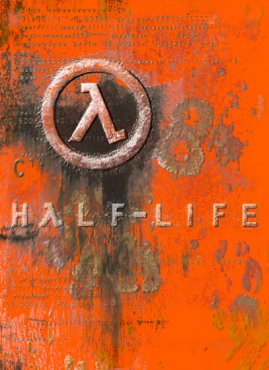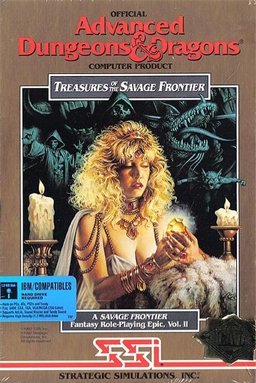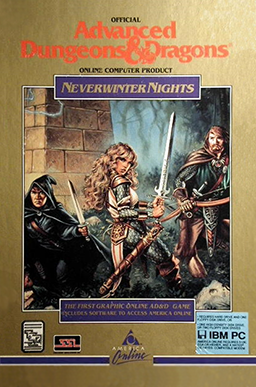
A gamemaster is a person who acts as an organizer, officiant for regarding rules, arbitrator, and moderator for a multiplayer role-playing game. They are more common in co-operative games in which players work together than in competitive games in which players oppose each other. The act performed by a gamemaster is sometimes referred to as "Gamemastering" or simply "GM-ing".
A massively multiplayer online role-playing game (MMORPG) is a video game that combines aspects of a role-playing video game and a massively multiplayer online game.

A role-playing game is a game in which players assume the roles of characters in a fictional setting. Players take responsibility for acting out these roles within a narrative, either through literal acting or through a process of structured decision-making regarding character development. Actions taken within many games succeed or fail according to a formal system of rules and guidelines.

Half-Life is a 1998 first-person shooter (FPS) game developed by Valve and published by Sierra Studios for Windows. It was Valve's debut product and the first game in the Half-Life series. Players assume the role of Gordon Freeman, a scientist who must escape the Black Mesa Research Facility after it is invaded by aliens during an experiment gone wrong. The gameplay consists of combat, exploration, and puzzle-solving.

Pool of Radiance is a role-playing video game developed and published by Strategic Simulations, Inc (SSI) in 1988. It was the first adaptation of TSR's Advanced Dungeons & Dragons (AD&D) fantasy role-playing game for home computers, becoming the first episode in a four-part series of D&D computer adventure games. The other games in the "Gold Box" series used the game engine pioneered in Pool of Radiance, as did later D&D titles such as the Neverwinter Nights online game. Pool of Radiance takes place in the Forgotten Realms fantasy setting, with the action centered in and around the port city of Phlan.

Doom 3 is a 2004 action horror first-person shooter video game developed by id Software and published by Activision. Doom 3 was originally released for Microsoft Windows on August 3, 2004, adapted for Linux later that year, and ported by Aspyr Media for Mac OS X in 2005. Developer Vicarious Visions ported the game to the Xbox, releasing it on April 3, 2005.

A role-playing video game, commonly referred to as a role-playing game (RPG) or computer role-playing game (CRPG), is a video game genre where the player controls the actions of a character immersed in some well-defined world, usually involving some form of character development by way of recording statistics. Many role-playing video games have origins in tabletop role-playing games and use much of the same terminology, settings and game mechanics. Other major similarities with pen-and-paper games include developed story-telling and narrative elements, player character development, complexity, as well as replay value and immersion. The electronic medium removes the necessity for a gamemaster and increases combat resolution speed. RPGs have evolved from simple text-based console-window games into visually rich 3D experiences.

Half-Life: Opposing Force is an expansion pack for the first-person shooter game Half-Life. It was developed by Gearbox Software and published by Sierra On-Line for Windows on November 19, 1999. Opposing Force was the first expansion for Half-Life and was announced in April 1999. Lead designer Randy Pitchford noted that he believed Gearbox was selected to develop Opposing Force because Valve, the creators of Half-Life, wanted to concentrate on their future projects. Over the course of development, Gearbox brought in a variety of talent from other areas of the video games industry to help bolster various aspects of design.

Dungeon Siege is an action role-playing game developed by Gas Powered Games and published by Microsoft in April 2002, for Microsoft Windows, and the following year by Destineer for Mac OS X. Set in the pseudo-medieval kingdom of Ehb, the high fantasy game follows a young farmer and her companions as they journey to defeat an invading force. Initially only seeking to warn the nearby town of the invasion of a race of creatures named the Krug, the farmer and the companions that join her along the way are soon swept up in finding a way to defeat another race called the Seck, resurgent after being trapped for 300 years. Unlike other role-playing video games of the time, the world of Dungeon Siege does not have levels but is a single, continuous area without loading screens that the player journeys through, fighting hordes of enemies. Also, rather than setting character classes and manually controlling all of the characters in the group, the player controls their overall tactics and weapons and magic usage, which direct their character growth.

3D Monster Maze is a survival horror computer game developed from an idea by J.K. Greye and programmed by Malcolm Evans and released in 1981 for the Sinclair ZX81 platform with the 16 KB memory expansion. The game was initially released by J. K. Greye Software in December 1981 and re-released in 1982 by Evans' own startup, New Generation Software. Rendered using low-resolution character block "graphics", it was one of the first 3D games for a home computer, and one of the first games incorporating typical elements of the genre that would later be termed survival horror.

Albion is a single player role-playing video game developed and published by Blue Byte for MS-DOS in 1995. It was originally released in German, then translated to English for international release. The game uses a science fiction setting that incorporates traditional fantasy elements, such as magic.
The following outline is provided as an overview of and topical guide to video games:

An action role-playing game is a subgenre of video games that combines core elements from both the action game and role-playing genre.
Computer-assisted gaming (CAG) and computer-assisted wargaming (CAWG) refer to games which are at least partially computerized, but where on important part of the action is not virtual but performed in real life or on a miniature terrain. Regulation of the game can be done completely by a computer or partly deferred to a human referee. Computer-assisted gaming attempts to combine the advantages of PC games with those of face-to-face games. In computer-assisted gaming, computers are used for recordkeeping and sometimes for the resolution of combat, but a Human referee makes any decisions requiring judgement.

The relationship between women and video games has received extensive academic and media attention. Since the 1990s, female gamers have commonly been regarded as a minority. However, industry surveys have shown that over time, the gender ratio has become closer to equal. Beginning mainly in the 2010s, women have been found to make up around half of all gamers. The gender ratio differs significantly between game genres, and women are highly underrepresented in genres such as first-person shooters and grand strategy games. Sexism in video gaming, including sexual harassment, as well as underrepresentation of women as characters in games, is an increasing topic of discussion in video game culture.

Treasures of the Savage Frontier (1992) is a Gold Box Dungeons and Dragons role-playing video game. It was developed by Beyond Software and published by SSI for the Amiga and DOS.
Life simulation games form a subgenre of simulation video games in which the player lives or controls one or more virtual characters. Such a game can revolve around "individuals and relationships, or it could be a simulation of an ecosystem". Other terms include artificial life game and simulated life game (SLG).

Neverwinter Nights was an early multiplayer online role-playing game to display graphics, and ran from 1991 to 1997 on AOL.
Arsys Software (アルシスソフトウェア), later known as Cyberhead (サイバーヘッド), was a Japanese video game software development company active from 1985 to 2001.
This list includes terms used in video games and the video game industry, as well as slang used by players.












